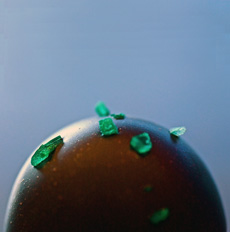
In this Olive Oil Rosemary Truffle, fresh rosemary is infused with the cream to make the ganache. Photo courtesy of Compartes.com.
Last Updated May 2018 |
Product Reviews / Main Nibbles / ChocolateChocolate GlossaryTerms & Definitions: H, I, J, K, L
On this page you’ll find terms including hot chocolate (different from cocoa) and infusion and limited edition chocolate bar, and learn a bit about the health benefits of chocolate. If you think we should consider chocolate terms and definitions other than those we have provided click on the Contact Us link on this page. Also enjoy our other 60 food glossaries. Use this index bar to visit other pages. a b c d e f g h i j k l m n o p q r s t u v w x y z This glossary is protected by copyright and cannot be reproduced in whole or part.
HACIENDAA plantation or estate where cacao is grown. HARVESTCacao is harvested throughout the year; but the main growing seasons are November to January and May to July. HAZELNUT PRALINÉSee gianduja. HEALTH BENEFITS OF CHOCOLATECacao has a high concentration of antioxidant-rich phytochemicals called flavanols, but once the cacao is converted into chocolate, it acquires a substantial amount of sugar and fat that are not exactly heart-healthy. Plus, the amount of flavanols in the chocolate are diluted with the addition of sugar and milk. Although research indicates that cacao may improve blood flow and even reduce the formation of clots, 2,300 calories a pound is a high price to pay for prophylactic measures. Cocoa powder made with lowfat milk and a minimum of sweetener is the best way to consume cacao antioxidants. Choose a cocoa powder that has not been “Dutched”: Dutching destroys phytochemicals. HOT CHOCOLATEHot chocolate, as first served by the Swiss, is different from hot cocoa. The latter is made with defatted cocoa powder; the former is made by pouring hot milk over shaved chocolate. Since chocolate contains cocoa butter, hot chocolate is a much richer beverage. Read more about the difference between cocoa and hot chocolate, and our reviews of the best of both. IER CRUActually 1er Cru, not ier Cru, an abbreviation for premier cru: 1er is French for 1st, or premier growth. The term, originally applied to the best vineyards in Bordeaux, has been adopted by growers of cacao and coffee beans to designate their finest-grown beans. INFUSE or INFUSIONInfusion is a method of flavor extraction that incorporates flavors such as fruits and nuts into chocolate by steeping and removing. For example, orange zest is added to melted chocolate and then the chocolate is strained to remove the zest. The chocolate retains the orange flavor without actually possessing any of the orange itself. INTERIORA term describing the insides or centers of confections that are enrobed with chocolate. JAVAA prime growing area for quality beans, often used in milk chocolate because they usually offer bold flavors that can withstand the dilution of the milk solids and the relatively low cocoa content. Javanese beans are usually characterized by a dark tone of leather and smoke, although lighter flavors are sometimes found, such as lemon and sweet spice. KAKAWAThe word for cacao used by the Olmec civilization, the first cultivators of cacao and the earliest known name for the plant. The word survives in Mixe-Zoquan the language of the people native to what is now Honduras. KASTANJESPronounced kas-TAN-ya, a molded, chestnut-shaped chocolate. It may or may not have a chestnut-flavored fillin; most often, it is filled with ganache. The preferred chestnut confection is marrons glacés, candied chestnuts. LECITHINLecithin can be extracted from egg yolks or soybeans (when it is called soya lecithin, and is generally the type of lecithin used by most chocolate makers). It is a natural product used as a thinner in chocolate. As an emulsifier, it helps maintain an emulsion (attachment) between the cocoa butter and the sugar. It also increases the chocolate’s fluidity (pliability) through the reduction of viscosity. (Cocoa butter is also added to for this purpose.) When no lecithin is added, the chocolate is dense and thick and tends to keep air inside the bar, which can create a rough surface texture including air bubbles. However, some of the finest chocolatiers, including Domori and Michel Cluizel, elect not to emulsify their chocolate, as they believe it interferes with nuances of taste in the cacao. Their chocolate is outstanding because of the overall care and quality of their production process. LIMITED EDITION CHOCOLATE BARSome companies, such as Amano and Scharffen Berger, produce “Limited Edition” bars. This means that there aren’t enough beans to warehouse for future batches, and the small crop has an unusual flavor that can’t be guaranteed to be duplicated in next season’s crop—assuming the beans are available at all. Hence, only a limited number of bars that taste like this can ever be produced. LIQUID CHOCOLATENot real chocolate but a product developed for baking convenience, made with vegetable oil rather than cocoa butter. It comes in individual one-ounce squeeze packages and requires no melting. However, it delivers neither the flavor nor the texture of regular chocolate. Continue To Next Page: Terms With M
Lifestyle Direct, Inc. All rights reserved. Images are the copyright of their respective owners.
|
Last Updated May 2018
© Copyright 2005-2025 Lifestyle Direct, Inc. All rights reserved. All images are copyrighted to their respective owners.